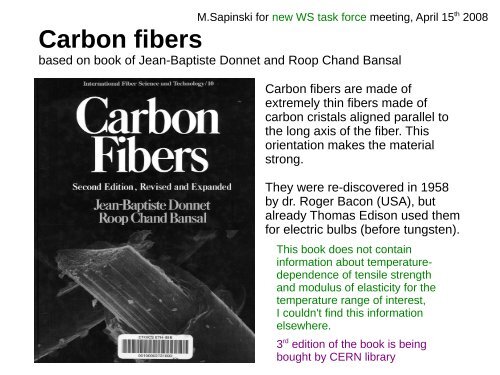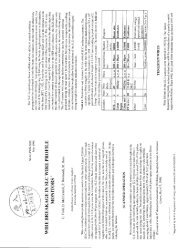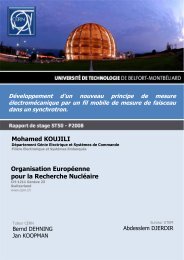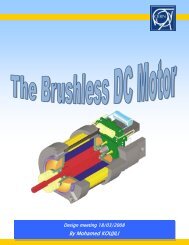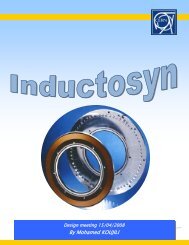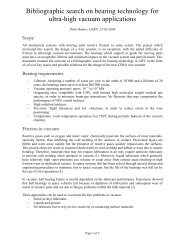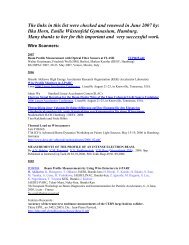Carbon fibers - Wire Scanner Design Project web - CERN
Carbon fibers - Wire Scanner Design Project web - CERN
Carbon fibers - Wire Scanner Design Project web - CERN
You also want an ePaper? Increase the reach of your titles
YUMPU automatically turns print PDFs into web optimized ePapers that Google loves.
M.Sapinski for new WS task force meeting, April 15 th 2008<br />
<strong>Carbon</strong> <strong>fibers</strong><br />
based on book of Jean-Baptiste Donnet and Roop Chand Bansal<br />
<strong>Carbon</strong> <strong>fibers</strong> are made of<br />
extremely thin <strong>fibers</strong> made of<br />
carbon cristals aligned parallel to<br />
the long axis of the fiber. This<br />
orientation makes the material<br />
strong.<br />
They were re-discovered in 1958<br />
by dr. Roger Bacon (USA), but<br />
already Thomas Edison used them<br />
for electric bulbs (before tungsten).<br />
This book does not contain<br />
information about temperaturedependence<br />
of tensile strength<br />
and modulus of elasticity for the<br />
temperature range of interest,<br />
I couldn't find this information<br />
elsewhere.<br />
3 rd edition of the book is being<br />
bought by <strong>CERN</strong> library
M.Sapinski for new WS task force meeting, April 15 th 2008<br />
<strong>Carbon</strong> <strong>fibers</strong><br />
production and classification<br />
They can be obtained from many materials but in modern industry the most<br />
used precursor is polyacrylonityle (PAN). Other materials: rayon, pitch...
M.Sapinski for new WS task force meeting, April 15 th 2008<br />
<strong>Carbon</strong> <strong>fibers</strong><br />
tensile strength of various types<br />
Definition: “The tensile<br />
strength of a material is<br />
the maximum amount of<br />
tensile stress that it can be<br />
subjected to before<br />
failure.”<br />
Max about 3 Gpa<br />
There is a study<br />
suggesting that the<br />
compression strength<br />
decreases with HTT
M.Sapinski for new WS task force meeting, April 15 th 2008<br />
<strong>Carbon</strong> <strong>fibers</strong><br />
tensile strength as a function of diameter<br />
Two possible reasons:<br />
1. defects - volumetric<br />
effect<br />
2. minimization of the<br />
carbon core which contains<br />
less-oriented crystals<br />
therefore is weaker
M.Sapinski for new WS task force meeting, April 15 th 2008<br />
<strong>Carbon</strong> <strong>fibers</strong><br />
tensile strength as a function of length<br />
Longer length – more defects along<br />
the fiber and the largest defect<br />
normally defines the strength of the<br />
whole fiber (not in our case!)<br />
Summary:<br />
1. for PAN carbon <strong>fibers</strong> reaches<br />
maximum for HTT of about 1500 C (but<br />
some studies suggest higher T)<br />
2. the stress during oxidation increases<br />
strength (optimum value exists),<br />
3. also the atmosphere during oxidation<br />
plays role (air better than oxygene)<br />
4. precursor fiber properties<br />
5. strength is better for shorter <strong>fibers</strong><br />
6. larger diameter = smaller strength<br />
7. neutron irradiation increases strength<br />
8. flaws and defects decrease strength<br />
(21 GPa – graphite whiskers): etching to<br />
eliminate surface flaws
M.Sapinski for new WS task force meeting, April 15 th 2008<br />
<strong>Carbon</strong> <strong>fibers</strong><br />
modulus of elasticity<br />
Moduli of elasticity of carbon <strong>fibers</strong> seem to be a direct function of degree of<br />
preferred orientation (with respect to fiber axis)<br />
Typical values 100-550 GPa.<br />
(plot from <strong>web</strong>)
<strong>Carbon</strong> fiber for <strong>Wire</strong> <strong>Scanner</strong><br />
there are 2 sources of stress:<br />
a) momentum transfer from the beam – transverse to the wire long axis<br />
(likely small for LHC-beam)<br />
b) stress due to thermal expansion of the spot punctually heated by the beam<br />
(compression stress, tensile strength = compression strength,<br />
pre-stress is factor 10-20 smaller than tensile strength)<br />
Linear expansion coefficient g for<br />
graphite is about 2% (from [1],<br />
for graphite: depend on direction)<br />
for 3800 K<br />
Linear expansion<br />
produces<br />
compression stress<br />
due to Hooke's law<br />
σ=ΔT g E<br />
Small E = small stress,<br />
high tensile/compression<br />
strength = more difficult to<br />
break<br />
But: the speed of sound in graphite v=2.3●10 5 cm/s, therefore typical stress<br />
relaxation time is BeamSize/v ie. About 100 ns which is 5000 times shorter than<br />
heating time during the scan.<br />
[1] Y.S.Touloukian, et al. “Thermophysical Properties of Matter”
<strong>Carbon</strong> fiber for <strong>Wire</strong> <strong>Scanner</strong><br />
summary<br />
We do not need to maximize tensile strength at high temperature.<br />
Modulus of elasticity should small, so it does not produce strong stresses<br />
(to melt carbon a 10 MPa is needed)<br />
Therefore we need intermediate modulus <strong>fibers</strong>, probably 7 microns or so.<br />
A special kind with proper HTT, etching etc. should be used to optimize <strong>Wire</strong><br />
<strong>Scanner</strong> performance.<br />
Points:<br />
o) with fiber of 7 microns instead of 30 microns we decrease the energy deposited<br />
in the downstream magnets by factor ~ 15.<br />
o) coefficient of thermal expansion can also be optimized<br />
Manufacturers/researches should be contacted Still no answer from prof. Donnet,<br />
another specialist contacted


